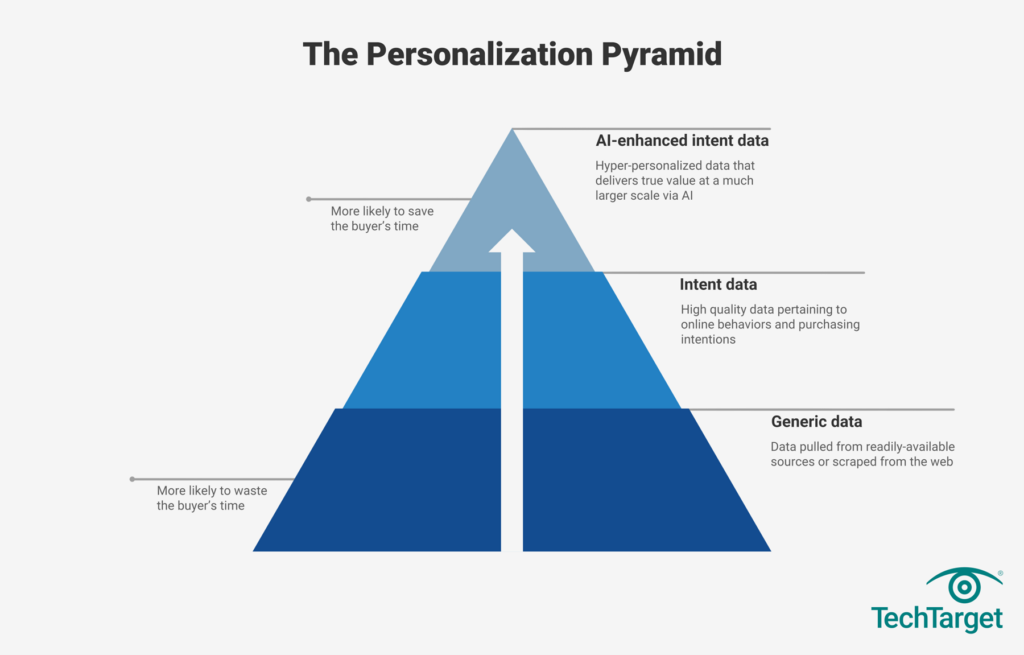As a marketing strategist with over a decade’s worth of experience, I’ve seen personalization strategies that run the gamut from compelling and persuasive to weak and ineffectual. And the hard truth is that the same tired strategies based on the same tired data aren’t going to differentiate your business.
In this article, we’ll examine how generative AI (GenAI) and intent data can work together to drive deeper personalization at scale.
Personalization: What it is (and what it isn’t)
Personalization refers to the truly unique interactions, content and messaging that speed the buying journey by speaking directly to a buyer’s problems and pain points. It does not pertain to personal interests, nor is it merely personal information scraped from the web.

In today’s environment, generic data – like information pulled from online sources – is readily available. If every business is using the same generic data and employing the same outreach strategies, your content and messaging are going to look equally generic. There’s nothing there to separate what your organization is doing from what Business B or Business C or Business D is doing.
Take, for example, this email sent to our CEO:

Nothing in the attempt at personalization here – the recipient’s name, the company he works for, the state in which it operates – demonstrates a knowledge of the recipient or an understanding of his challenges. The call to action at the end of the email is, likewise, too general to deliver any real value.
The power of GenAI to improve response rates: TechTarget’s real-world improvements
When it comes to member engagement, we at TechTarget believe in the fundamental principle of putting the right content in front of the right prospective buyers at the right time. We’re able to match content with our readers’ needs by personalizing each and every user experience, targeting individual users based on the recency of their activity as well as the topical areas around which they’ve been active. This technique of leveraging intent data and recency of activity alone results in a 1.7x increase in response rates.
However, when we add machine learning (ML) models into the mix in order to discern the expected content needs of our readers and make predictive recommendations that match relevant content with their activities, the difference in response rates is nothing short of momentous: combining intent data with AI results in a staggering 3.6x response rate increase. The AI-enhanced personalization strategy has also seen improvements in longer-term outcomes, including customer retention and engagement.
The bottom line, based on our own testing, is this: there’s a ton of value in activity data, but you can really unlock the full power of that data when you add in AI to scale your personalization efforts.
Learn more about TechTarget’s IntentMail AI to learn how to tap into the full power of your data.
Avoiding “Big Brother” language
At its strongest, personalization allows you to connect with users based on their individual profiles and day-to-day challenges. While content and messaging based on generic data will likely fail to resonate with the intended recipients, swinging too far in the opposite direction can be downright Orwellian. To avoid coming across as an all-knowing “Big Brother”, adhere to these best practices:
| Do | Don’t |
| Be the solution your audience is looking for without telling them that you knew they were looking for it. |
Come off like you’re looking over their virtual shoulder by using language like “TechTarget told us that you viewed XYZ …” |
|
Use your knowledge of prospects’ topical activity to send relevant content and messaging that aligns with the trends or pain points they’re researching. |
Remind your audience that their online activity is being tracked – it’s no secret that it happens, but the reminder can be a major turnoff. |
|
Position yourself as a helpful partner who sympathizes with their challenges to demonstrate you understand their perspective, provide content that’s likely to appeal to them and show how your brand and products can fulfill their needs. |
Overuse explicit references to content downloads or research history – be mindful of the difference between a message that says, “Thanks for viewing!” and one that says, “Because you downloaded content X, do you want to talk to a rep about product Y?” |
When trying to find the right balance between personalized messaging and potentially off-putting messaging, consider the idea of progressive disclosure – that is, building a relationship based on your previous interactions and reflecting that progression in your messaging. Just as you’re unlikely to ask intimate questions of someone you just met, a similar concept applies here: you need to establish a relationship with your intended recipient before you can expand upon it.
Done strategically, combining high quality data with GenAI enables stronger personalization at scale
Personalization refers to the interactions, content and messaging that speaks to a buyer’s challenges and saves them time. Adding GenAI to your targeting efforts can deliver much greater value than using intent data and user activity alone. The key is to find balance between GenAI and human-driven efforts – by bringing the two together you can achieve high-quality personalization at scale.




